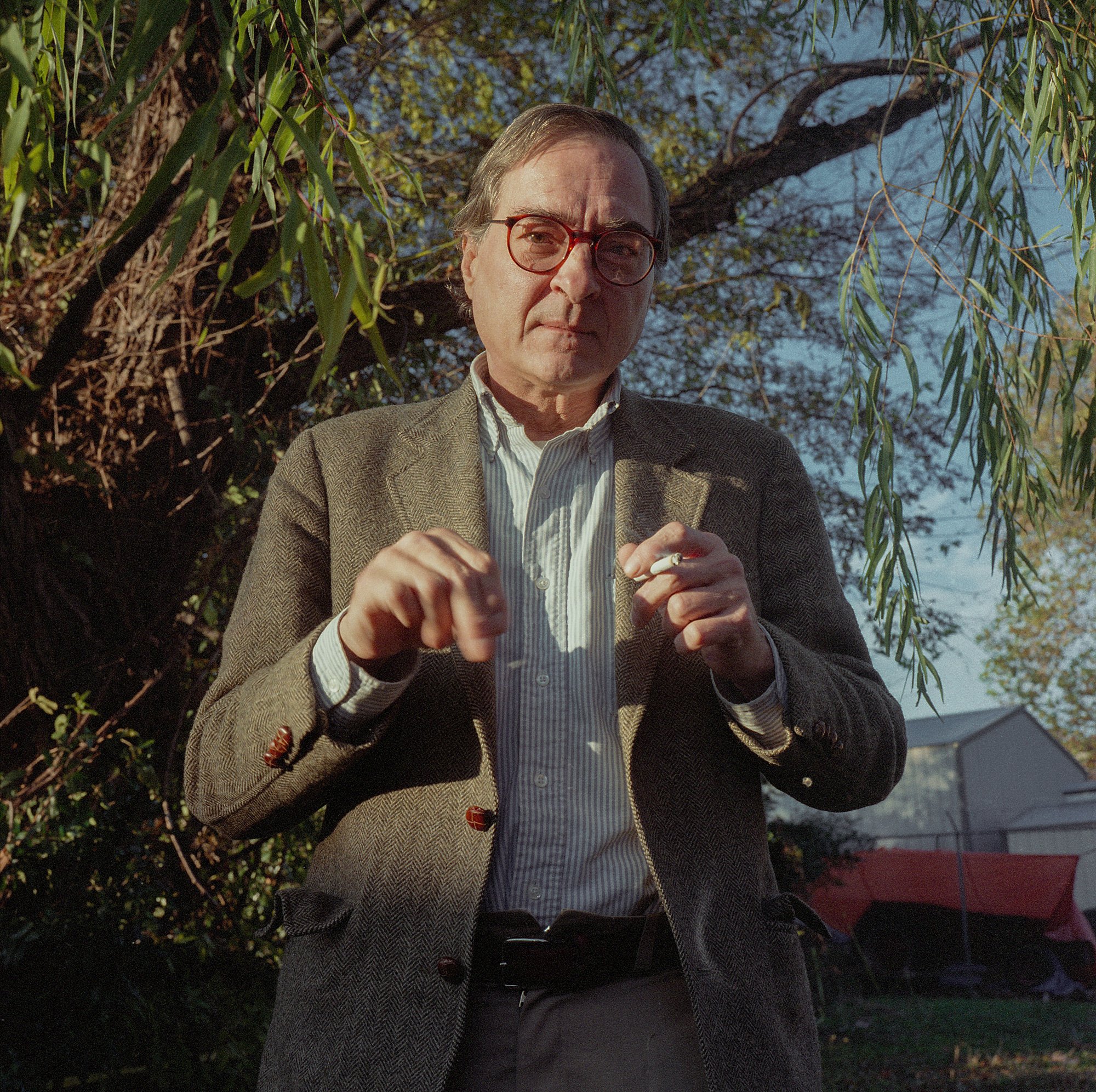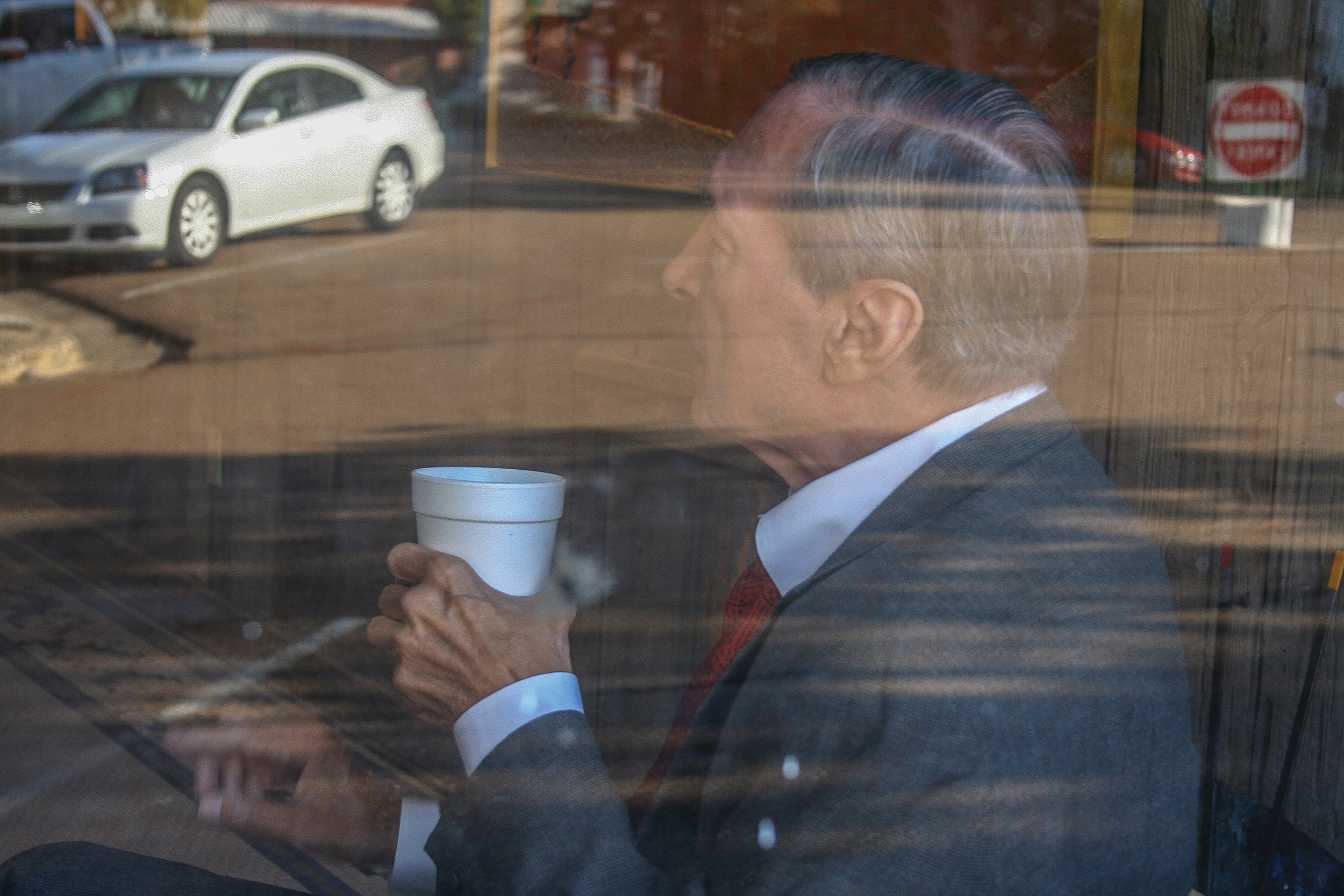In the mid-1990s, Mississippi photographer Maude Schuyler Clay interviewed her cousin, “the godfather of color photography,” William Eggleston. She recently pulled the exchange out of her attic and graciously shared it with The Bitter Southerner.
Interview & Photos by Maude Schuyler Clay
Intro by Kyle Tibbs Jones
January 11, 2022
“My attic is infested with brown recluse spiders, but the boxes are up there somewhere. Let me see what I can find. I’ll call you back.”
It’s July, and I’m just off the phone with photographer Maude Schuyler Clay. I’d called to ask about her images but also about family photos and any letters or memorabilia from over the years. Across the South, it’s hotter than three hells, and she’s in Sumner, Mississippi, without air conditioning. Still, she doesn’t miss a beat. Listening to Maude speak in that drowsy thick accent feels akin to someone brushing your hair. And to be regaled by her Bill Eggleston stories with a clear understanding of their family’s place in the history of photography? That puts you in a trance.
Maude Clay and the great William Eggleston are cousins. Their mamas were sisters. Eggleston was born in Memphis and grew up on the cotton farm his family owned in Mississippi. Maude still lives in the old home place on Cassidy Bayou, with her husband, also a photographer, Langdon Clay. They lovingly call the family home, built in 1910, Grey Gardens South, thus the brown recluse situation. Cousin Bill lives just two hours up the road in Memphis.
Eggleston’s work, for which he’s received a Guggenheim Fellowship, a National Endowment for the Arts Fellowship, and the Getty Images Lifetime Achievement Award, has been exhibited from Birmingham to Berlin.
Today, William Eggleston is 82 years old, and he and Maude don’t visit quite as often. But lucky for us, in one of those boxes in the attic, guarded by poisonous spiders, deep in the Mississippi Delta, Maude found a treasure.
Editor’s Note: The following is an interview from the mid-1990s: a time-capsule moment with one of the South’s most celebrated photographers. It’s quintessentially Old School, with all that this implies.
Maude Schuyler Clay: When did you get interested in photography?
William Eggleston: I got interested in the first year of college at Vanderbilt — the fall of 1957. I bought a Canon, a developing kit, some Nikkor tanks, and a set of chemicals. I just couldn’t believe how fantastic it was. My grandfather [Judge Joseph Albert May] had all that stuff around when I was little.
MSC: Then later, in the 1960s, you discovered the work of other photographers?
WE: Well, someone gave me the book The Decisive Moment [1952] by Henri Cartier-Bresson. His weren’t like any other photographs; for instance, they weren’t like those being published in Life magazine. Cartier-Bresson had this golden, brilliant period when he was young, kind of like Robert Frank did.
MSC: [Robert Frank came to the United States in 1947 from Switzerland. In the mid-’50s, he traveled around from coast to coast taking photographs which were later made into an iconic book, The Americans, with an introduction by Jack Kerouac: “ ... with that little camera that he raises and snaps with one hand he sucked a sad poem right out of America onto film, taking rank among the tragic poets of the world.”] Were you aware of somebody like Robert Frank when you started working?
WE: I found out about Frank when I went by coincidence to his great 1962 show at the Museum of Modern Art in New York.
MSC: When did you start working in color?
WE: About 1966.
MSC: Did you do that consciously, or did you just get a roll of color film and try it out?
WE: I had seen a bunch of Technicolor movies and I had these dreams about fantastic color schemes that I was working out in my mind. And I just knew it was going to work. I went out and took a few rolls — I think the first roll was at the old Montesi’s [a Memphis grocery store] in the late afternoon sun.
MSC: Is that the one of the guy with the grocery cart?
WE: Yes, that was the first picture, the first frame.
MSC: How did you get it developed? Did you just take it to the drugstore?
WE: Yes. I got all those drugstore snapshots back, and about a year later I got together what I thought were the best ones and had some so-called professional prints made in Chicago. And then I knew I was on to something, but I didn’t have any place to show them. [My wife] Rosa Kate and I started traveling to Europe all the time. Some of those trips I’d stop in New York. When I finally got enough prints printed, I showed John Szarkowski [director of photography at MoMA] what I was doing. They were real surprised anyone from the South was doing something sophisticated in photography.
MSC: You mean surprised that you were consciously thinking about photography as an art form instead of, say, journalism?
WE: Exactly. They thought nothing was going on in the South. There was no real modern art here outside of a few writers.
MSC: There was so much political and social turmoil going on, who had time for art? The social upheavals were what people were coming here to photograph in the South of the 1960s.
WE: That’s right. All that was going on.
MSC: Did you ever say, “I need to go out and photograph a Civil Rights march?”
WE: No. To me, that was just history happening, as opposed to making something artistic. We did go to JFK’s funeral in Washington; I took some photographs of that: the riderless horse, Jackie in her long black veil, all the crowds lined up.
MSC: You funded all your projects yourself?
WE: Yes, nothing cost very much then. First I put a darkroom together, and later I had those prints made in Chicago. I didn’t have any real funding until I got the Guggenheim [Fellowship] in 1974. Then I put all that money into an experiment to see how good cheap color prints could be. I did thousands of 8-by-10s in the cheapest print process known: lab-print school pictures by Rainbow Labs. That whole corpus constituted my Guggenheim. I didn’t have one fancy print made, which turned out [to be] a good thing to do.
MSC: And then you had a show?
WE: I had several small shows, like the one at the Dupont Center in Washington, but I didn’t have any big show until the MoMA show in May of 1976. That was all dye transfer prints, and that was a big deal — big in the sense that we planned that show for a couple of years. Unlike other shows, which you can put together in a month.
MSC: You spiraled onto the national art scene in 1976. Did Szarkowski have a preconception of your work being about “The South?”
WE: He saw it as a hermetic piece of work. He says in his introduction [to William Eggleston’s Guide, the catalog to the MoMA show in 1976] that it is more about photography than about the place, but it happens to record the place, as it had never been seen before.
MSC: William Eggleston’s Guide. Did you or Szarkowski make up that title?
WE: We did it together, but only after John said he wanted something like the MICHELIN Guide.
MSC: Was the implication that it was a guide to some strange part of the world, or just a map?
WE: I think it was a guide to someone’s private world.
MSC: But not necessarily a Southern private world?
WE: It had to be some of that because it’s about the South.
MSC: There have been many occasions when you have said that you are not a Southern photographer.
WE: I don’t think my pictures are conceived that way, no.
MSC: Did you have any idea you were doing a double service by, for instance, photographing all the signs and buildings in the ’60s and ’70s that are now gone? Did you ever think about being a preservationist in any way?
WE: I wasn’t aware they’d be gone so soon! I just thought I could make new pictures and include all that information that was around. It wasn’t so hard to do back then, because that stuff was everywhere.
MSC: One of the greatest pleasures of looking at your photographs is realizing their importance, in that they record a world in the South that is virtually gone.
WE: That is one of the things that the photographs accomplished. I really didn’t think of them so much as the last vestiges, but they were.
Maude Schuyler Clay was born in Greenwood, Mississippi. After attending the University of Mississippi and the Memphis Academy of Arts, she assisted the photographer William Eggleston. Her work can be found at the Museum of Modern Art, the National Museum of Women in the Arts, The Museum of Fine Arts in Houston, and the High Museum in Atlanta, among others. Her books Delta Land (1999) and Delta Dogs (2014) both received the Mississippi Arts and Letters Award. In 2015, her book Mississippi History, with a foreword by Richard Ford, was published by Steidl. From 1998 to 2002, she served as the photography editor of The Oxford American. She continues to live and work in the Delta.







